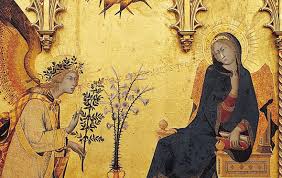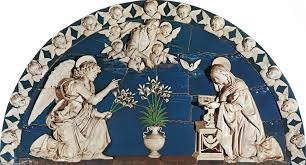Over the course of this blog we have looked at four Annunciations, one each by Simone Martini, Della Robbia, Botticelli, Leonardo. In the process we have discussed the five stages of the Annunciation which are present in the text in Luke, Chapter 1: 26-38 in the Bible. Michael Baxandall introduced these stages for visual images of the Annunciation in his interpretations of 15th-century sermons in his 1972 book Painting and Experience in Fifteenth-Century Italy (Oxford.) In that book he made a case for five stages: FEAR, REFLECTION, INQUIRY, ACCEPTANCE, and MERIT.
FEAR: Simone Martini's Annunciation of 1333 in the Uffizi is an example of the FEAR STAGE. The Madonna recoils from the Angel and has a frown on her face.
TEXT in LUKE 1: 29 - And when she saw him she was troubled at his saying.

REFLECTION:
Both Botticelli's Lehman Collection Annunciation (1485-92) and Della Robbia's Annunciation in the Ospedale degli Innocenti of 1470 are examples of the REFLECTION STAGE. The Madonna looks down at her book and holds one hand on her breast.
TEXT IN LUKE 1: 29: and she cast in her mind what manner of salutation this should be.
Lehman Collection Annunciation by Botticelli, Met Museum, New York.
Della Robbia Annunciation, Ospedale degli Innocenti, 1470.
Both are REFLECTION
INQUIRY: Leonardo's Annunciation now in the Uffizi is an example of Inquiry. The Madonna holds up one hand and stops reading, looks directly at the angel.
TEXT IN LUKE 1: 34: Then said Mary unto the angel, "How shall this be, seeing I know not a man?"

INQUIRY
ACCEPTANCE: FRA ANGELICO's Annunciation at the top of the stairs in San Marco.
The Madonna folds both hands over her chest and bows her head to the angel.
TEXT in LUKE 1: 38 - And Mary said, "Behold the handmaid of the Lord. be it unto me according to thy word."
MERIT stage - is difficult to convey in visual images and is rarely painted in the 15th century.
This stage involves the hymn to God that Mary says in her heart and this part of the text occurs after she has visited Elizabeth and is praising God for the miracle that has happened. Merit may include part of the text referred to as the Magnificat.
TEXT Luke 1: 46-47: My soul doth magnify the Lord. And my spirit hath rejoiced in God my Savior.
For our purposes this part of the story of the Annunciation is not represented in Annunciation scenes.
But for all other Annunciations of this period, it is possible to see in the gestures of Mary and sometimes of the Angel the FOUR different STAGES that are mentioned in the sermons with regard to the Luke text.
So now you can test these whenever you see an Annunciation in a museum. For instance, which stage is being represented here?

Yes, Acceptance, and here?
Botticelli predella panel for San Marco Coronation, Uffizi, 1488-90


and Della Robbia's Annunciation made for La Verna, Italy, 1470's?
Yes, both Reflection
And sometimes it is possible to see artists trying to represent two stages at once or the state of being
in between two stages: Between FEAR AND REFLECTION: Botticelli, Annunciation, Uffizi, 1489.
 Between FEAR AND REFLECTION:
Between FEAR AND REFLECTION:Donatello's Annunciation, terracotta, 1433, Church of Santa Croce, Florence
BETWEEN REFLECTION AND INQUIRY
Piero della Francesca's Annunciation in San Francesco, Arezzo, 1462.
BETWEEN REFLECTION AND ACCEPTANCE: Filippo Lippi's Annunciation, c. 1435-40, National Gallery of Art, Washington, D.C..

Most of the representations of the stages are dependent on the gestures of the Madonna, and the Angel's gestures often match hers, but in some cases not.
The story of the introduction of the thought of pregnancy and the actuality of pregnancy is a story which most human beings can relate to since it is the story of reproduction. It is also a story about the major change in a life cycle of a human being where a single person stops thinking about life alone and starts to think about another human being's welfare. The story of creation that transforms most people as they travel from birth to death is portrayed as a common theme here, and is what continues to make Annunciation scenes appealing. The idea that that creation is God's doing is the nature of this particular pregnancy scene since Mary is a Virgin and has "not known a man." In all of these Annunciation scenes the messenger who delivers the miraculous news is a neuter or male angel; sometimes together with God the Father who is actually up in heaven looking down, as in the Piero della Francesca image, and sometimes with God suggested by hands sending out the dove of the Holy Spirit to convey the heavenly nature of the magic, as in Fra Filippo Lippi's 1449-59 Annunciation in the National Gallery in London.

The universal notion of wooing and acceptance of wooing is repeated over and over again in fifteenth-century images and sermon discussions. The excitement of young love is what seduces the artists and the viewers and makes the Annunciation the fertile ground for representing the hidden sexuality of all ages. It is the uncertainty before the final act that is most moving and meaningful.







Thank you for the many examples of the Annunciation stages. While I was familiar with Roberto Caracciolo's classification and Baxandall's book, I sometimes struggled to find appropriate examples.
ReplyDeleteYou're very welcome. Hope this post helped.
Delete